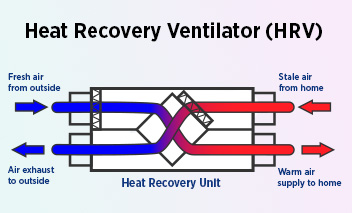Practical Tips to Maximize HRV Performance
The All-Inclusive Guide to the Uses of Heat Recovery Ventilation in Modern Structures
Heat Recovery Ventilation (HRV) systems stand for a considerable development in building innovation (HRV Heat Recovery Ventilation). They supply an approach for exchanging stale indoor air with fresh exterior air while reducing power loss. This approach not only improves indoor air high quality however additionally contributes to power efficiency in both property and industrial buildings. Recognizing the numerous applications and advantages of HRV can reveal its vital duty in contemporary layout and sustainability efforts. The ramifications of this technology deserve exploring further
Comprehending Heat Recovery Ventilation Equipments

Several modern structures focus on power effectiveness, recognizing heat recuperation ventilation (HRV) systems is essential for optimizing interior air quality and minimizing power intake. HRV systems function by moving warm from stagnant indoor air to inbound fresh air, successfully preserving comfy indoor temperature levels while decreasing energy loss. These systems contain a warmth exchanger, fans, and ductwork that assist in the flow of air. Throughout winter season, HRV systems catch and recycle warmth from the outgoing air, while in summer season, they can aid cool down inbound air. By constantly trading air, HRV systems also minimize humidity and the focus of indoor toxins. Correct installation and upkeep of HRV systems are vital for their performance and effectiveness in improving overall building efficiency and comfort.
Advantages of Heat Recovery Ventilation
Heat recovery ventilation systems provide numerous benefits that enhance both energy effectiveness and indoor air high quality in modern buildings. By recording and reusing power from exhaust air, these systems considerably reduce cooling and heating expenses, bring about lower energy usage. In addition, they keep a consistent flow of fresh outdoor air, lessening the danger of indoor air pollutants and allergens. This continuous exchange assists regulate humidity levels, preventing mold development and making certain a healthier living environment. Furthermore, HRV systems add to sustainability goals by lowering overall carbon impacts. Their capability to optimize ventilation without giving up thermal convenience makes them an important addition to contemporary building design, advertising both economic and eco-friendly benefits.
Applications of HRV in Residential Buildings
As property owners increasingly prioritize energy efficiency and indoor air high quality, the applications of heat healing ventilation (HRV) systems in residential structures have actually ended up being extra widespread. HRV systems are especially useful in tightly secured homes, where maintaining fresh air flow is essential for protecting against wetness buildup and interior contaminants. They successfully move heat from outward bound stale air to incoming fresh air, lowering power costs related to heating & cooling. Furthermore, HRVs can improve comfort degrees by managing humidity and temperature level. They are additionally versatile for numerous household styles, consisting of single-family homes and multi-unit structures. Generally, integrating HRV systems supports lasting living methods while making sure a much healthier interior atmosphere for residents.
HRV in Industrial and Commercial Setups
In business and industrial settings, the application of warm healing air flow (HRV) systems has come to be significantly crucial for optimizing power performance and maintaining air high quality. These systems successfully transfer heat from exhaust air to inbound fresh air, minimizing the demand for added home heating or cooling. This not only lowers power prices however additionally contributes to sustainability initiatives. Industries such as production, warehousing, and office structures profit significantly from HRV systems, as they help control temperature level and humidity degrees, making sure a comfortable and efficient environment. HRV systems help in eliminating pollutants and excess wetness, boosting indoor air top quality. As check regulations around air top quality end up being stricter, the adoption of HRV modern technology is most likely to grow, making it a critical element of modern-day industrial and industrial framework.
Future Trends in Heat Recovery Ventilation Innovation

Frequently Asked Questions
Exactly How Does Heat Recovery Ventilation Effect Indoor Air High Quality?
Heat recovery ventilation greatly enhances indoor air high quality by continually exchanging stale indoor air with fresh exterior air while recovering energy. This process minimizes toxins, maintains optimal humidity levels, and ensures a much healthier atmosphere for owners.
Can HRV Systems Be Installed in Existing Structures?
HRV systems can certainly be set up in existing structures. Retrofitting may call for browse around these guys alterations to ductwork and ventilation formats, but it considerably enhances power effectiveness and interior air quality, making it a viable alternative for older structures.
What Upkeep Is Needed for HRV Systems?

Are There Details Climates Where HRV Is Much More Effective?
Heat recovery ventilation systems are specifically effective in climates with substantial temperature level distinctions between seasons. These systems enhance energy effectiveness by recuperating warmth from exhaust air, making them ideal for both chilly and reasonably warm environments.
Just How Do HRV Equipments Affect Energy Bills?
